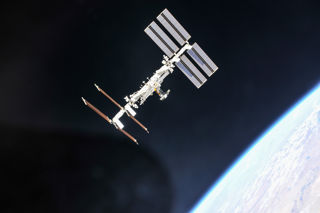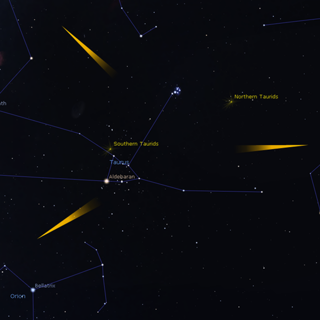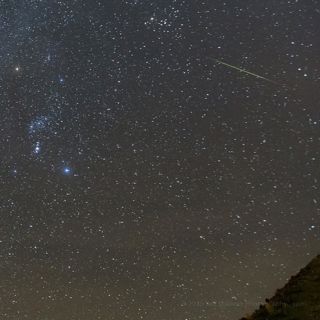
What's Happening in Space: November 2024
- 25th Oct 2024
- Author: Dhara Patel
A summary of space events through the month
Dhara Patel is a Space Expert at the National Space Centre, working to help share space science, stories, and topical news with our visitors and online audiences. Each month she curates a round-up of some notable space and science events coming up the weeks ahead.
This November keep an eye out for the peak of the Northern Taurid meteor shower, the launch of Blue Origin's New Glenn rocket and a full moon!
28th Oct – 1st Nov – spot Comet C/2024 S1 (ATLAS)
There may be another visible comet to spot late October / early November – though it may have already broken apart. Whilst astronomers can predict the position of comets, there are no guarantees when it comes to their brightness and therefore naked-eye visibility, due to the different processes responsible for their appearance. Comet C/2024 S1 (ATLAS) brightened rapidly after it was discovered in September 2024 – thought to be the result of the comet fragmenting and releasing lots of gas and dust. Since then, it has dimmed and faded. If it survives its close encounter with the Sun and begins making its way back out into the solar system, then we might see it brighten again and appear visible over the following days. Look towards the east just before sunrise, the comet, if visible, will be near the bright star Spica in the constellation of Virgo. It will be very close to the horizon and may be drowned out by the bright glare of the Sun as it rises, so could prove tricky to spot - having a pair of binoculars or telescope to hand would be handy. The fragmenting comet should leave a trail of gas and dust so you might observe a tail-like feature, and there is a possibility that we could even spot a “headless” comet should it completely break apart!

Throughout November – spot the International Space Station
There may be sightings throughout November to spot the International Space Station moving across the sky – use NASA’s Spot the Station to find out when and where to spot the largest artificial satellite overhead.
1st November – new moon (12:47)
The new moon will occur in the constellation of Libra. The lack of moonlight interference provides a great time to try and view deep sky objects (especially with the aid of binoculars and telescopes). We have a blog on ‘phases of the moon’ written by Mike Darch in our Education team: https://spacecentre.co.uk/blog-post/moon-phases/
5th November – Moon and Venus close in the sky
Following the turn of midnight on 5th November, the thin waxing crescent moon will be in conjunction (sharing the same right ascension – coordinate) with Venus, and the pair will be at their closest angular separation (close approach) just before, in the closing minutes of 4th November. However, the pair will be below the horizon at this time, so not visible from the UK. Rather, you can try to catch the Moon and Venus in close proximity around sunset in the west, when the pair will be just above the horizon. A clear view without tall buildings or trees that may block your view, will help you spot the pair more easily. When they become visible, the duo will be too widely separated to fit within the field of view of a telescope or a pair of binoculars but will be visible to the naked eye. Find out more about conjunctions and other astronomical phenomena in our blog written by David Southworth in our Education Team: https://www.spacecentre.co.uk/news/space-now-blog/astronomical-phenomena/.
10th/11th November – Moon and Saturn close in the sky
Just after midnight on 11th November, the waxing gibbous moon will be in conjunction (sharing the same right ascension – coordinate) with Saturn and the pair will be at their closest angular separation (close approach) around the same time. From the UK, they’ll have set below the horizon about an hour before, so won’t be visible at that time. Instead try and catch the pair during the late hours of 10th October when they’ll be in close proximity over the south-western horizon. The pair will be observable form around sunset and will get closer together as the night unfolds but will move closer to the horizon so clear views without tall buildings or trees that may block your view, will make spotting them easier. They should remain observable until around midnight and will be close enough to fit within the field of view of a telescope and will also be visible to the naked eye or through a pair of binoculars. Check out the astronomical phenomena blog linked above to find out more about conjunctions and close approaches.

11th/12th November – peak of the Northern Taurid meteor shower
The Taurid meteor shower is composed of two streams: The Southern Taurids which peak between 4th and 5th November and the Northern Taurids which peak between 11th and 12th November. The Northern Taurids is a relatively weak shower with 5-10 meteors per hour at its peak and due to its similar orbital parameters, is thought to be produced by asteroid 2004 TG10 - a possible large fragment of comet Encke, the cause of the Southern Taurids. The Taurids don’t have very definite peaks and instead ramble along in October and November and are especially noticeable from late October into early November when they overlap. Best viewing will be from a dark location after midnight on the 11th into the early hours of the 12th . Meteors will radiate from the constellation of Taurus (in the south around midnight) but can appear anywhere in the sky. The waxing gibbous moon will be up throughout the night setting in the early hours after midnight, so moonlight interference shouldn’t be a problem if you’re observing in the hours before sunrise. The Taurids are rich in fireballs (particularly bright meteors) but their rate is low. When Taurids appear, they’re big and bright but you’re likely to only see a few meteors per hour – still, it’s well worth a watch but you’ll need patience. Find out more in our Northern Taurid meteor shower 2024 blog: https://www.spacecentre.co.uk/news/space-now-blog/northern-taurid-meteor-shower-2024/
15th November – full moon (21:28)
Known as the Beaver moon (according to the old Farmers’ Almanac), this full moon is named to mark when people would set beaver traps, or when beavers became very active, getting ready for winter. Check out the “Full Moon: Full Facts” blog written by Mike Darch in our Education team to find out more about full moons: https://spacecentre.co.uk/blog-post/full-moon-facts/.
16th November – Mercury at greatest eastern elongation
Because Mercury orbits closer to the Sun than Earth, it always appears quite close to the Sun in the sky being lost in its glare most of the time. However, Mercury will be at its furthest separation from the Sun on 16th November when it reaches greatest eastern elongation, making it a great time to try and spot the Sun’s closest planet. Look to the southwest as the Sun sets – it will be very close to the horizon, so you’ll need a good clear view without tall buildings and trees. Check out the astronomical phenomena blog above to find out more about greatest elongations and other astronomical phenomena.

16th/17th November – peak of the Leonid meteor shower
A minor shower, ~ 10 meteors per hour at its peak, this meteor shower is produced by dust left behind by Comet Tempel-Tuttle. The meteors will radiate from the constellation of Leo (rising above the eastern horizon after midnight) but can appear anywhere in the sky. Peaking on the night of the 16th and into the morning of the 17th, the waning gibbous moon will be up in the night sky, so moonlight interfere is likely to block out the fainter meteors this year. If viewing is done from a dark location, it may be possible to catch a few meteors during this minor shower. The radiant will continue to rise higher into the sky during the early morning of the 17th, so it might be best to head out after midnight and look until just before sunrise when the radiant will be in the south-east. Occasionally, the display turns sublime: every 33 years or so, there have been instances of the Leonids producing meteors at a rate of about 1,000 — or more — in an hour! However, this won't happen again until 2034. Find out more in our Leonid meteor shower 2024 blog: https://www.spacecentre.co.uk/news/space-now-blog/leonid-meteor-shower-2024/
17th November – Uranus at opposition
Because Earth and Uranus have different orbits and orbital speeds, the distance between them is constantly changing. On 17 November, appearing in the constellation of Taurus (not far from the Pleiades / Seven Sisters), Uranus will be on the opposite side of the Earth compared to the Sun so it will roughly be at its closest approach to Earth and its face will be fully illuminated by the Sun. The Sun, Earth, and Uranus will be in ‘syzygy’ or a roughly straight-line configuration. At the time of opposition, Uranus will be brighter than at any other time of the year and will be up all night long making it the best time to view and photograph the planet. Catch the spectacle from the late evening on 17 November – it will rise in the east and set in the west the following morning so ideally look towards the south around midnight. It will be difficult to make out as more than a star-like point of light without the aid of a telescope, even when at its closest point to the Earth. Check out the astronomical phenomena blog above to find out more about oppositions and other astronomical phenomena.
17th November – Moon and Jupiter close in the sky
During the afternoon of 17th November, Jupiter will be in conjunction (sharing the same right ascension – coordinate) with the waning gibbous moon. They will also be at their closest angular separation (close approach) shortly before, but they’ll be below the horizon at this point, so won’t be visible. Instead, wait until sunset and look to the northeast as the pair begin to rise into the night sky. The duo will be too widely separated to fit within the field of view of a telescope or a pair of binoculars but will be visible to the naked eye. Check out the astronomical phenomena blog linked above to find out more about conjunctions and close approaches.
20th November – Moon and Mars close in the sky
On the evening of 20th November, Mars will be in conjunction (sharing the same right ascension – coordinate) with the waning gibbous moon. They will also be at their closest angular separation (close approach) shortly after and will have just risen above the northeastern horizon at this time, so will be observable. As they come into view around 21:00, they’ll be close to the horizon to begin with so an open location with clear views would be helpful, but they’ll rise higher into the sky throughout the night, reaching their closest angular separation around 22:30 in the east (though will drift further apart as they do). Whilst the duo will be too widely separated to fit within the field of view of a telescope, they will be visible to the naked eye and through a pair of binoculars together. Check out the astronomical phenomena blog linked above to find out more about conjunctions and close approaches.

November – New Glenn debut launch
New Glenn is a heavy-lift rocket developed by Blue Origin. It is named after NASA astronaut John Glenn, the first American astronaut to orbit Earth and has been designed to deliver larger payloads to orbit. This maiden flight of the New Glenn launch vehicle will be carrying the prototype Blue Ring payload tug and payload hoisting platform (a spacecraft platform capable of refuelling, transporting, and hosting satellites). Additionally, this mission will serve as New Glenn's first National Security Space Launch certification flight. Due to launch in November from Cape Canaveral, Florida, USA, New Glenn will help reduce the cost of space exploration and improve access to space. Find out more about the New Glenn launch vehicle in this blog written by Ed Turner in our Education team: https://www.spacecentre.co.uk/news/space-now-blog/new-glenn-blue-origins-flagship-launch-vehicle/
